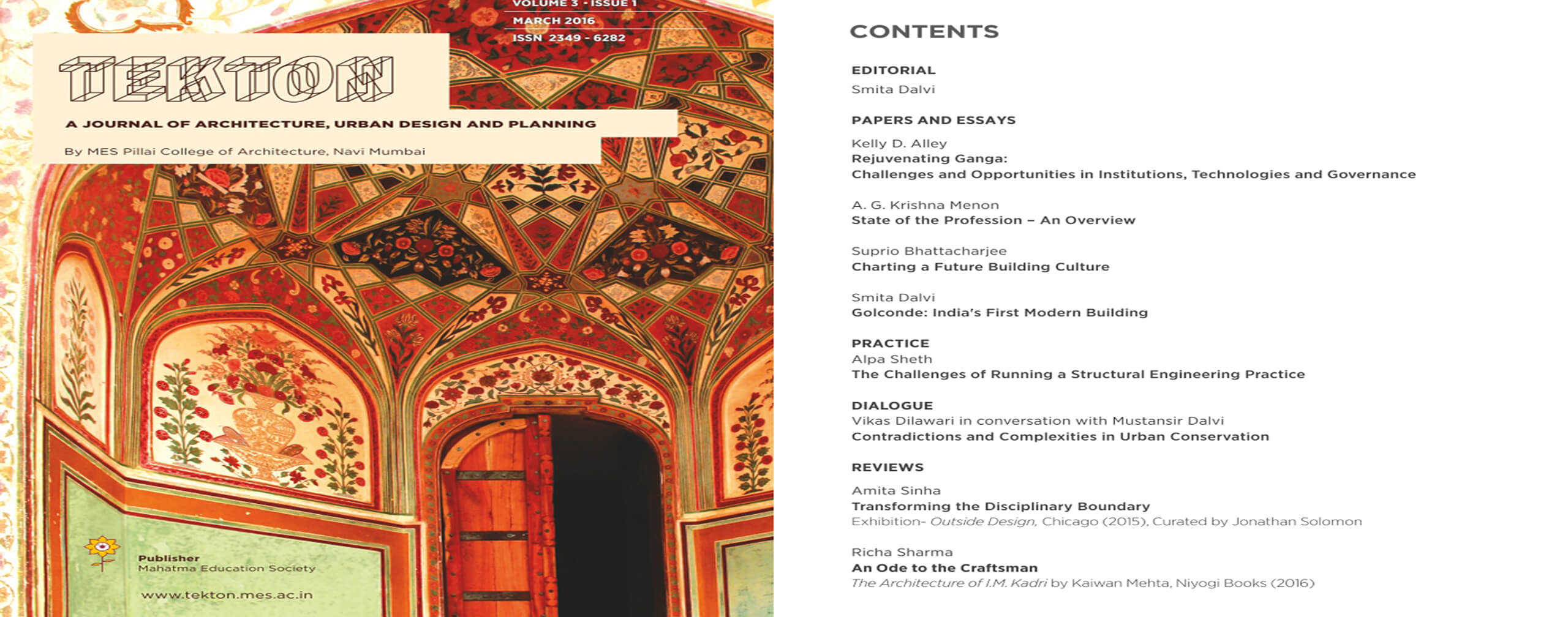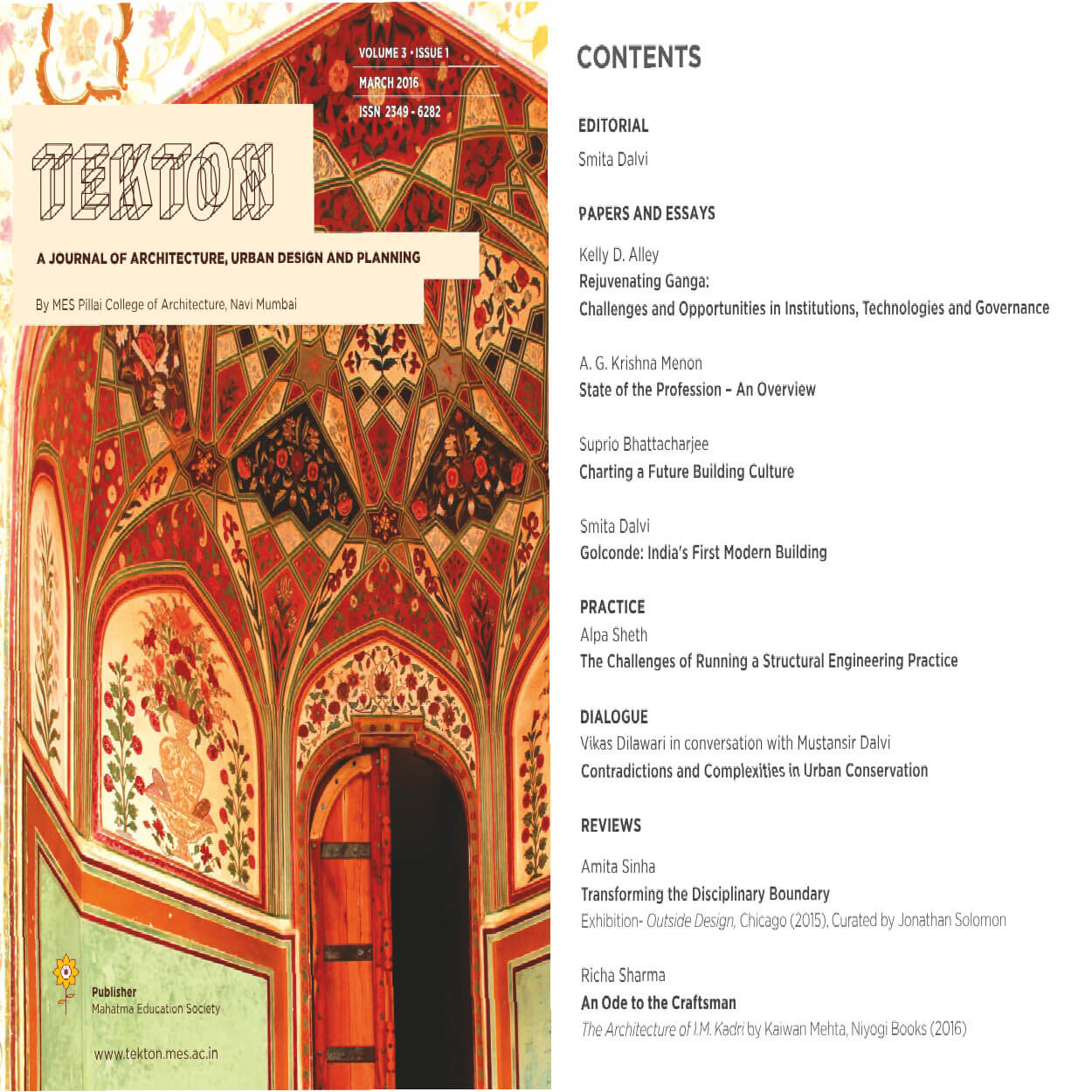17 Dec Smita Dalvi


Those who engage in valuable research had no access to a quality journal to publish and disseminate their work.
There has been a lack a credible architectural journal with even a modicum of academic rigour in writing and a peer review process. There are many trade magazines, most only do reportage on new projects with glossy pictures at best, or purveyors of products and lifestyle at worst. Some better ones have declined and have receded in their role of measuring the pulse of the profession. There is a near total lack of published material on Indian architects (barring a few stars) and their works. There are just a handful of monographs made possible only through self-publishing.

That this is the only mode available for even the most deserving architects is because culture of architecture book publishing does not exist. This will change only when we have more credible writing and a readership that is hungry for it. We have produced very little critical writing on architecture of pre and post-independence. There is a crying need for researching and interpreting the 20th century and our present times if only we can come out of the thrall of ‘documentation’ obsession.

Women architects have been invisible from discourse on architecture, till recently when new research has begun to record their contribution. While, the country has scores of institutes offering post-graduate programmes in architecture including PhDs, there is little awareness about the ropes and ethics of research-based writing and publishing. Those who engage in valuable research had no access to a quality journal to publish and disseminate their work.

There has been a lack of ecosystem for research, writing and academic publishing. We have not sufficiently progressed beyond the simplistic view of architecture as vocational training and practicing a trade. This has hindered production of new knowledge so vital for a robust architectural culture.
Editing a journal therefore is also a form of curation. One has to look into generating content that stands up to the rigour and scrutiny and also into cultivating a readership for longform writing.
It is with this background that the journal I now edit emerged. Tekton occupies this space of academic publishing hitherto missing. A culture of discursive, longform writing where a writer draws out a subject critically with supporting arguments – essential in other streams of the humanities – needs to be nurtured in architecture. One can say from the experience of bringing out nine issues so far that featured works of tenured professors to well-known architects and academics to young researchers, and even undergraduate students that this space is highly rewarding.

One can say that the peer review process which is at the heart of credible academic publishing is considered de jure in western academia but is not so well understood here. Tekton as an academic journal has a process in place for submission of research papers/ essays/ reviews, followed by a peer review process, this would work ideally only in a well-established academic culture of publishing. For a fledgling journal like ours one can never guarantee a steady flow of paper submissions. One also has to contend with sub-par or unscrupulous offerings and reject them outright.

One should keep in mind that there is no requirement of any sort of writing or research, let alone of peer-reviewed publications for promotions to higher posts in architecture education in India. Editing a journal therefore is also a form of curation. One has to look into generating content that stands up to the rigour and scrutiny and also into cultivating a readership for longform writing.

As a curatorial editor, the task therefore is to engage with budding researchers to develop their papers, invite known researchers to contribute on selected subjects, and to carry out a peer review process supplemented by editorial reviews to maintain a good standard of writing. Academic publishing is a learning process for all concerned and one hopes that it will flourish with mutual support as long as its value is recognised.
Reading and writing are equally essential skills. We need to stop valourising anti-intellectualism.
Who, ultimately, speaks for Indian architecture? How effective are the several potential ‘mouth-pieces’ in articulating positions in architecture specific to our country and region? Is there any critical self-reflection within the profession? Writing and criticism must hold a mirror to the profession. Every other creative field – arts, cinema, theatre, books – has to contend with critics then why do architects consider themselves above and beyond external review?

The space and relevance for research is undervalued in academia. It is time to stop looking at practice and theory as binary opposites. Theory is not outside of practice, rather in constant interplay it produces new knowledge, freshens and renews relevance and offers new meanings to our circumstances. Reading and writing are equally essential skills. We need to stop valourising anti-intellectualism.

Research and writing must be made accessible both in its form of writing and its dissemination. Obtuse or pedantic writing locked away behind paywalls is self serving. Make books affordable, make the journals openly accessible. Use new technologies to reach your writing to young people. Who gets to speak about architecture? Whose voices have weight to bring about a change in moribund patriarchal profession and academia? Why are women not in leadership roles? Why do we still have ‘Manels’ of old fashioned, conservative people mouthing the same old platitudes? Where are the dissenting voices?
Pen is mightier than the sword. Women architects, reclaim your voice through writing. Claim your rightful place in the histories past and future. Interpret the contemporary times from the lens of your experiences. Bring a fresh new socially responsive perspective to architecture. Redefine how architecture is understood and practiced. Create a whole new polemics and make the world a better place.
Smita Dalvi
DESIGN FIELD
Pedagogy, Design & Architecture
LOCATION
Mumbai, India
STUDIO NAME
Editor of Tekton, A Journal of Architecture, Urban Design and Planning, being published by the MES, Mumbai.
ABOUT
Smita Dalvi is a Professor at MES Pillai College of Architecture, Navi Mumbai and the editor of Tekton, A Journal of Architecture, Urban Design and Planning, being published by the MES, Mumbai.
She has been teaching architecture and aesthetics in Navi Mumbai and Mumbai. In 2007, she was awarded the fellowship of ‘Fulbright Visiting Specialist: Direct Access to the Muslim world’. Her research areas are in Architecture, History of Art & Culture, Urban Heritage and has read and published papers and essays in conferences and several architectural and cultural journals. In her research, she explores syncretism and inter-sections in art, architecture and society. She is an avid traveller and photographer.


